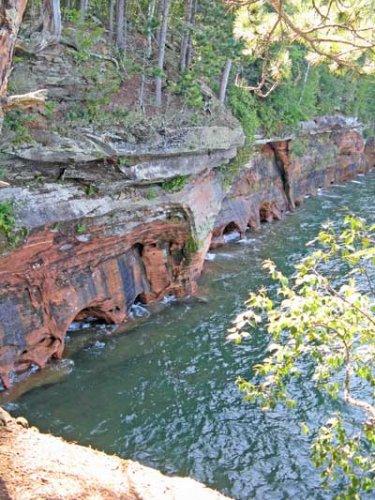A visitor to Apostle Islands National Lakeshore provided a different twist on the expression "A miss is as good as a mile" when he fell over a 35-foot cliff into the very chilly waters of Lake Superior. In his case, quick thinking and fast reflexes allowed him to miss the rocks at the bottom of the cliff, but his wet landing meant his troubles were far from over.
The mishap began on the afternoon of October 13th when Jacob Achterberg, 28, of Rhinelander, Wisconsin, was hiking with a group near the Lakeshore Trail in the park. This trail offers hiking in the park's mainland unit, and runs for about 4.5 miles past the cliffs above the mainland sea caves. Hiking information on the park website notes, "This trail is a rugged path for use by experienced hikers, with stream crossings and steep slopes along the way."
According to a park spokesperson, Achterberg slipped on loose rocks and slid down a steep slope and over a cliff edge, falling 35 feet into Lake Superior. The hiker gets credit for excellent reflexes and great presence of mind; he later told rescuers that he pushed himself away from the cliff face when he realized he was going over the edge in order to avoid hitting rocks below, and landed feet first in the water.
That very wet landing was vastly preferable to a hard one on the rocks, but Achterberg's misadventure had just begun.
The victim was able to swim approximately 30 yards along the cliff face, where he found and crawled onto a submerged ledge. The water temperature was 50 degrees and the air temperature was 54 degrees, and Achterberg was wearing only a t-shirt, jeans, and tennis shoes. He was clearly at serious risk from hypothermia.
Shortly thereafter, the park was notified by US Coast Guard Station Bayfield of a 911 call reporting that a man was stranded on a rock in Lake Superior, "somewhere between the mainland sea caves and Meyers Beach." The search area included over three miles of cliffs and rugged shoreline at the western end of the park, but efforts by the park's multi-divisional search and rescue team were successful.
According to the park's report, the team arrived to find Achterberg struggling to cling to the ledge as two-foot waves washed against him. The crew of the first NPS vessel on scene gave Achterberg a lifejacket, which he immediately put on but was unable to zip due to numbness in his hands caused by the cold conditions. The crew of the second NPS vessel maneuvered close to the cliff face and helped Achterberg get on board using the vessel’s loading ramp.
By the time he was rescued, Achterberg had been in the cold water for about an hour. NPS staff immediately began treating the victim for hypothermia and brought him to an NPS dock at Little Sand Bay. Achterberg was then transported by the Red Cliff Ambulance Service to a hospital in Ashland, where he was treated and released.




Add comment